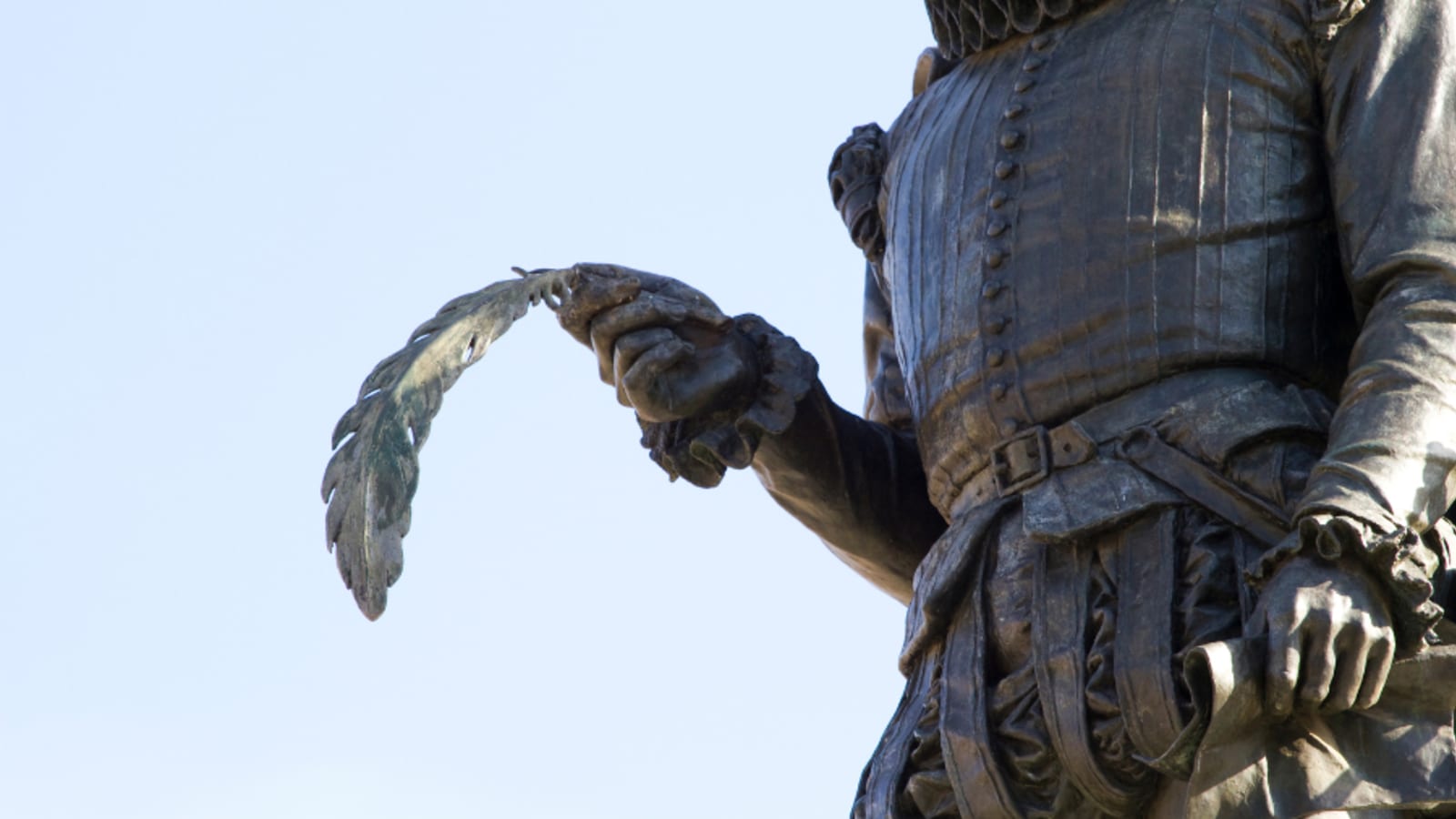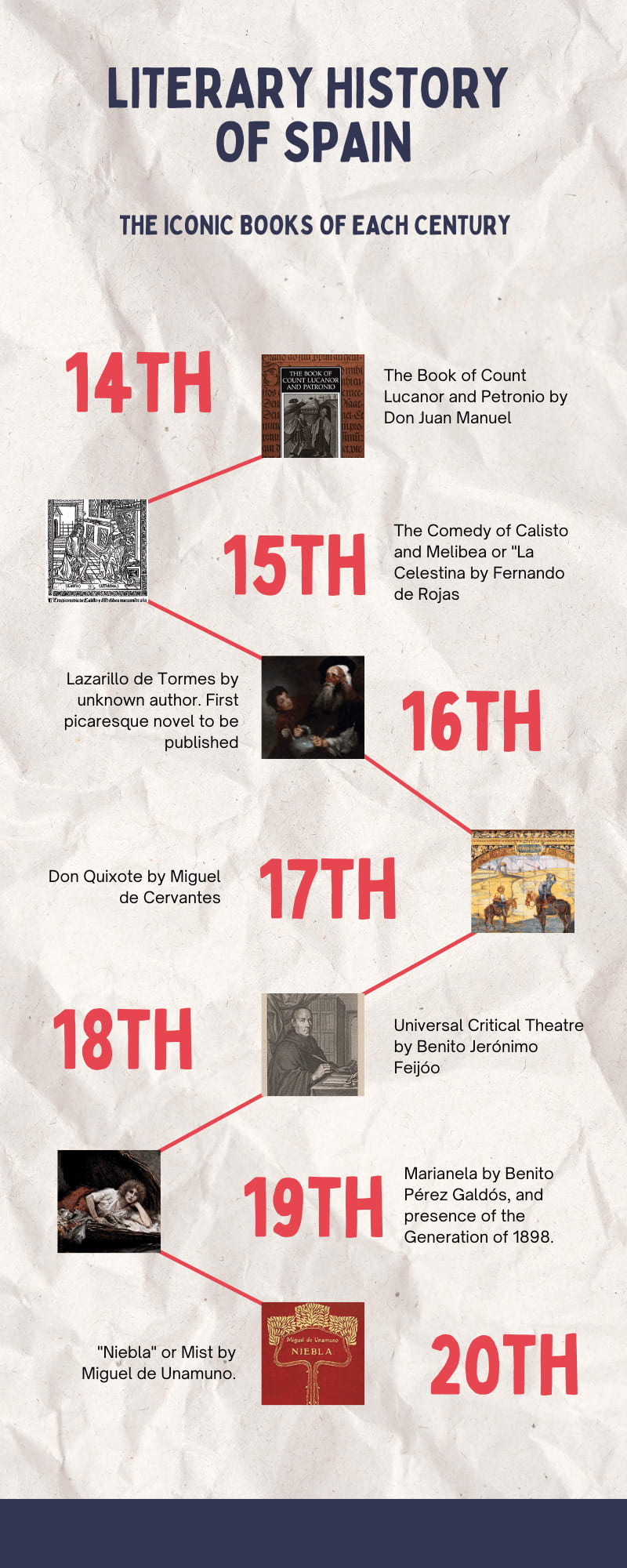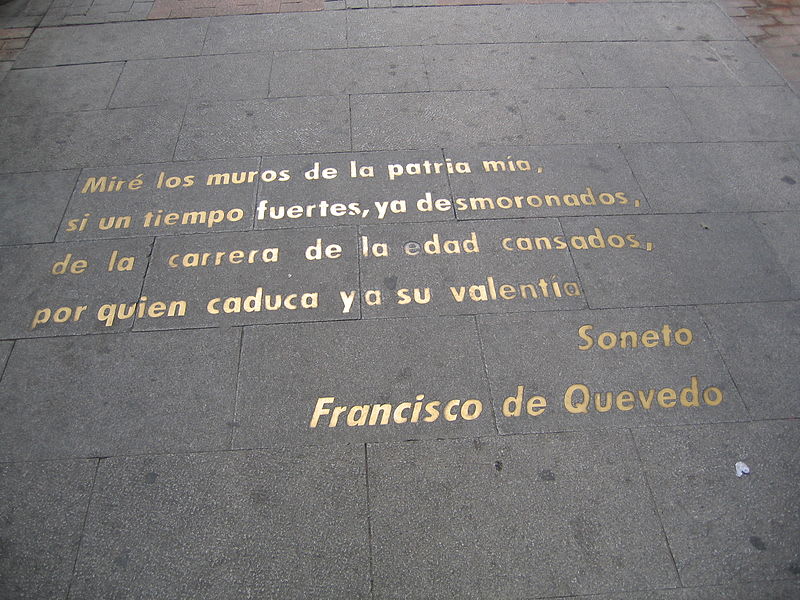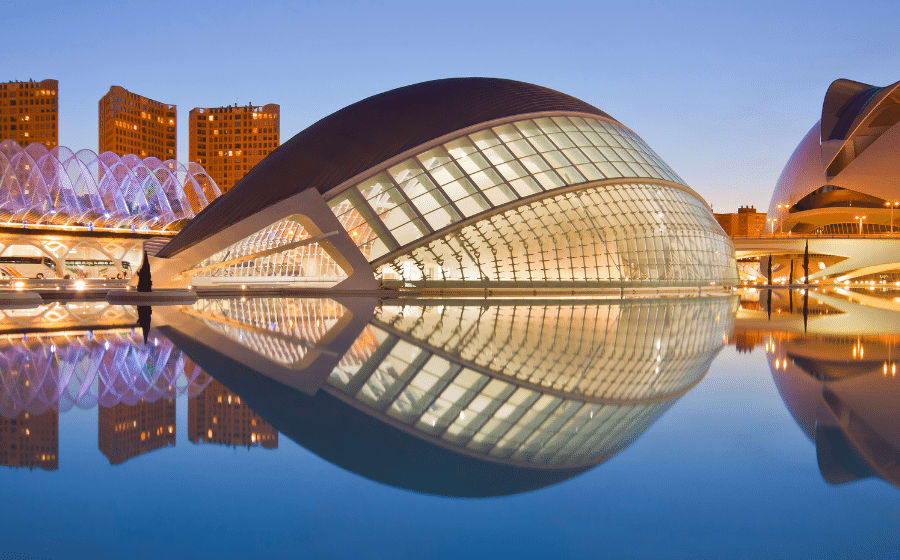Spanish Literature: Its History, the Classics, and The 3 Nobel Winners
December 5, 2022
Win a FREE Trip to Spain!
Exciting Announcement! For the first time, we're thrilled to offer exclusive trips to the heart of Spain - an experience like no other. This isn't your typical tourist journey; it's a unique opportunity to immerse yourself in authentic Spanish culture, alongside real locals and our passionate team.
But there's more! Simply by requesting information about this amazing trip, you'll be entered into a special draw to win a Fully Paid Trip to Spain for Two. And that's not all - everyone who inquires will receive an exclusive bonus gift, valued at $500, available only now.
Ready to Discover the Real Spain?Click Here ↑ to Request Information & Enter the Draw!
There are two types of people in this world, those who like reading and literature passionates. One thing in common, but they are very different people.
If you are reading this article, you are one of the latter. For you, reading a book isn’t enough; you need the context, the author’s story, the consequences, and more!
This article will find the most relevant moments of Spanish literature history, major classics, authors, and even a tour!
So, with no further a do. Let’s get your literary thirst satisfied!
Table of Contents ▼ ▶
History of Spanish Literature

There is a lot to say every time it comes to history, and literature is no exception. The history of Spanish literature is divided into the three main languages that people used after Latin: Castilian, Catalan, and Galician. Castilian literature is the most extensive of the three, as it became the official language of the Spanish Empire until today.
First of all, is there any record of literature pieces before Latin transformed into Castilian? Yes. Let us remember that Spain used to be Iberia, occupied by the Romans for thousands of years, and many essential thinkers were born on Spanish soil. Some of these people are the poet Lucan, Seneca the Younger, Seneca the Elder, and some women writers like Pola Argentaria and Teofilia.
After the Romans came the Visigoths and the Muslims; it was under the Al-Andalus Kingdom that the first vernacular writings emerged. Historians have found texts in Mozarabic, a vulgar/romance Latin dialect spoken under Muslim rule, and Hebrew.
During the reign of Alfonso X (1252-1284), while the Christians recovered the land from Al-Andalus, a wave of intellectuality emerged, and the first universities were founded. This king was also known as Alfonso the Wise because he fostered cultural development, encouraging the three cultures (Jews, Christians, and Muslims) to work together in his court. Why is he relevant to literature? Well, Alfonso, the Wise mandated the translations and compilations of the Classical, Oriental, Hebrew, and Christian texts to fused knowledge.
Since Alfonso, the Wise, any literature has received more attention and prestige. Three genres must be highlighted in the history of literature in Spain, which are poetry, drama, and prose.
There are records of heroic poetry even before Alfonso X. There is a text from the mid-12th century called “Cantar del Cid Mío,” which narrates a subjective view of Spain’s most famous knight, Rodrigo Díaz de Vivar. From the 13 century, there are records of rhythmic vernacular chronicles of the saint’s lives by Gonzalo de Berceo.
The 14-century saw the birth of more original content rather than compilations. It saw the birth of Spain’s first collection of prose fiction by the poet Juan Manuel (nephew of Alfonso X). Don Juan Manuel The Book of Count Lucanor and Petronio, a treatise on morals in the form of 50 short tales, in which Count Lucanor asks questions of his counselor. This century saw the emergence of chivalric romances. Another recurring theme was a misogynist treatise warning against women who were held responsible for the fall of men. This was, of course, written by men who dominated the field; some examples are An Anti-feminist Treatise of Fifteenth Century Spain by Luis Ramírez de Lucena, Count Lucanor by Juan Manuel, and Book of Good Love by Juan Ruiz.
The 15-century received the Renaissance, which was called the Golden Age for Spain. To give you some context, the Golden Age was when all the Spanish kingdoms unified into one empire and then traveled overseas with Christopher Columbus. Towards the end of the 15th century, an important piece of literature was the Comedia de Calixto y Melibea, also known as “La Celestina,” believed to be the first realistic novel.
As with every subject, 16th-century literature evolved and took a creative turn with novels. Spaniards got Lazarillo de Tormes, the first picaresque novel about a rogue ani-hero that does as he pleases.
Towards the end of 16th-century something completely new was cooking in the mind of a young author. The 17th-century saw Miguel de Cervantes revolutionized literature with his book Don Quixote, a romance chivalry delivered in two volumes. I will talk more about this classic below.
Don Quixote is the prototype of modern novels as Cervantes touched profound beliefs and perspectives through several characters.
So far, we have talked about prose, poetry, and novels. But what about drama or theater? Well, we are missing drama! By the 12th century, the drama was exclusively performed by the Church; the first interpretation known was for the Three Kings passage, which was known as “Auto de Los Reyes Magos.” Then, in the 15th century, Juan de Encina took the drama out of the Church when he adventured to perform his “Cancionero” (dramatic religious dialogues) to nobles. Then, Lope de Rueda took from courts to the market with one-act plays. Towards the end of the 16th century (1588), Juan de la Cueva was the first dramatist to the theatrical possibility of ballads. He interpreted comedies and tragedies from Classical antiquity and revived heroic legends.
- The 17th century saw drama development, with authors like Tirso de Molina and Lope de Vega working on comedies and tragedies with more depth. This century also witnessed the poetry and prose marked by “Culteranismo” and “conceptismo”. I think this definition by Britannica will be more precise than mine, so here you go:
“Culteranismo, the ornate, roundabout, high-flown style of which Luis de Góngora y Argote was archpriest, attempted to ennoble the language by re-Latinizing it. Poets writing in this style created hermetic vocabulary and used stilted syntax and word order, with expression garbed (and disguised) in Classical myth, allusion, and complicated metaphor, all of which rendered their work sometimes incomprehensible”.
“Conceptismo played on ideas as culteranismo did on language. Aiming at the semblance of profundity, conceptista style was concise, aphoristic, and epigrammatic and thus belonged primarily to prose, especially satire. Baltasar Gracián was the main author of this movement”.
- The 18th century experienced more philosophical literature. The enlightenment ideas influenced Spanish thinkers, and many produced essays. The second half of the century moved into a Neoclassical style with texts reflecting the logic, common sense, properness, and adequate societal performance.
- The 19th century saw the revival of the Spanish novel with different authors. There was much concern about developing Spanish intellectuality. One of them was Benito Perez Galdós, considered the best novelist after Cervantes. He perfected the realistic novel and created a new type of historical novel. In the transition to the 20th century, Miguel de Unamuno is one of the most remarkable authors, known for his existential pieces such as “Niebla” and “Abel Sanchez.”
Another major contribution to Spanish literature was the “Generación del ‘27” (1927 Generation), a group of poets influenced by Futurism, Surrealism, and Symbolism, the European movements of the period.
“They rejected traditional metre and rhyme and discarded anecdotal treatment and strictly logical descriptions in their poems. Instead, they made constant and audacious use of metaphor, coined new words, and introduced highly symbolic or suggestive images into their poems to convey aspects of inner personal experience” -Britannica
Most of the writers from this generation had to escape Franco’s dictatorship and restrictions on literature. Federico García Lorca is the most well-known author from this period. Lorca was a musician, dramatist, and poet; some of his pieces were “Gypsy Ballads” and “The House of Bernarda Alba”; he could never see the latter play on the scene because he was murdered under Franco’s dictatorship after being accused of being a communist. A link below will take you to the summary of this play!
As it was mentioned before, many authors left the country or stopped their art during the Civil War, which led to a decline in culture. In the 60s and ’70s, restrictions on arts began to relax, and artists were finally free after Franco died.
Now you have a snapshot of Spanish literary history, and there is more about modern writing in this article’s books and authors section.
Classic Spanish Books
Before getting into detail about four Spanish classics, let us shout out to all the Spanish authors. Spain is full of talented people that deserve recognition for their art. In this article, we will only mention four pieces, but if you want to find out about three other modern classics plus seven texts that will make you an expert in Spanish culture, head to the links below!
The 7 Best Spanish Books That Will Take You In Different Adventures
7 Books about Spain That Will Make a Cultural Expert Out of You

Don Quijote de la Mancha
Are you familiar with those parody horror movies that mock real thrillers? I bet you are. Don Quixote pioneered modern parodies, and I will detail many more things now.
“El Ingenioso hidalgo Don Quixote de la Mancha” (The Ingenious Gentleman Don Quixote of La Mancha) is one of the most-read books of history as it revolutionized the way of telling stories in the 17th century. Cervantes published his masterpiece in two parts; the first volume came out in 1605 and the second in 1615; less than ten years later, the book was translated into English.
The book tells the story of Alonso Quixano, a man with the title of the hidalgo (gentleman) that can no longer differentiate reality from fiction after reading book after book about romantic chivalry. This book is considered a Spanish classic for its contribution to literature. As we mentioned before, Don Quixote was a prototype for modern novels, set a standard for realism, and introduced topics that people had not experienced in a book before. Cervantes parodies ideals, throws criticism on his society, and creates the first polyphonic novel; this means that he presented reality through different perspectives.
If you didn’t study this at school, I highly recommend you keep a copy at home and read it at your pace.
Criticón
Remember conceptismo? One of the baroque styles of the 17th century dominated prose; the style is characterized by rapid rhythm, directness, simple vocabulary, witty metaphors, and wordplay. “El Criticón” by Baltasar Gracián is considered the peak novel of this style.
It tells the story of Critilio, an experienced man that by shipwreck, is thrown on the shores of an island where he meets Andrenio, a man raised by animals outside society. Once rescued, both embark on a long allegorical pilgrimage in various stages, delivered in three books. Gracián published his texts as the three main stages of manhood. First came “The Spring of Childhood” in 1651, then “The Autumn of Manly Age” in 1653, and “The Winter of Old Age” in 1657.
Niebla
“Niebla,” or Mist, is a literary text by Miguel de Unamuno published in 1914. “Niebla” is a Spanish classic because, once again, the author innovated with his art. Miguel de Unamuno coined the term “Nivola” to refer to his texts and set himself apart from realism, the prevalent style of the 20th century.
The book tells the story of Augusto, who, after a brutal heartbreak, contemplates suicide but decides not to after reading an essay and embarks on a journey to meet with the respective author. The surprise is that Augusto shares his existential problems with Unamuno, with whom he carries a deep conversation about life.
Famous Spanish Authors
You can read the complete biography of the following three Nobel winners plus two others in the next article:
Top 9 Spanish Writers That Speak from their Hearts - 5 Nobels!

1. José de Echeragay
José de Echeragay was the first Spanish to win the Nobel Prize for Literature, but that did not please the circle of literates of the country. Echaregay was a multifaced person; he was a scientist, a politician, and a writer. He graduated as an engineer and contributed to the scientific field with research on physics and mathematics. But that is not what got him a Nobel. At the age of thirty-two, he began his journey in literature with his first play, “La Hija Natural”; this was just the beginning of sixty-seven plays and many more books and speeches. The major literates of that period did not consider him worthy of the prize, but still, he was supported by foreign authors such as Bernard Shaw and Pirandello.
2. Jacinto Benavente
Jacinto Benavente was a writer from the mid-19th century who earned his Nobel Prize in Literature for his effort and continuation into Spanish drama. He was the second Spaniard to receive a Nobel. He wrote a total of 172 literary pieces before he died.
Benavente developed as a playwright, director, screenwriter, and film producer. His career as an author began with drama with a collection of plays. His first success was El Nido Ajeno (1894); after that, his most famous piece, The Governor’s wife, was published in 1901, and The Lady of the House in 1908.
3. Camilo José Cela
Camilo José Cela won his Literature Nobel Prize in 1989, two years after he was awarded the Premio Píncipe de Asturia de las Letras. He was also given the Cervantes Prize in 1995.
This author’s extensive portfolio includes most genres, including novels, essays, plays, and poems. One of his most famous poetry collections is Stepping into the dubious light of day, which he published right after the Civil War exploded. Then, Cela is mainly known for his book The Hive (La Colmena), which was banned in Spain during Franco’s dictatorship due to the erotic passages it contained. This Spanish author also had his book “The Pascual Duarte Family” become a movie and was nominated for the Cannes Festival.
Spain’s Literary Tour
Well, it is not much of Spain as many of the places I mention are in Madrid, but it is indeed a literary tour that will take you through the path of many of Spain’s most famous writers.

Barrio de las Letras
The Literary Quarter is one of Madrid’s most beautiful neighborhoods. This quarter was home to many of Madrid’s most remarkable authors of the 17th century, like Lope de Vega. I recommend walking the entire neighborhood because it is filled with small theaters, open-air bars, and tablaos. Nevertheless, the three main spots you must see are Calle Huerta (Huerta Street), where you’ll feel like you are inside a book as you walk over phrases and sonnets from famous artists. Second, the Plaza Santa Ana is the right place to enjoy a drink and tapas in front of the Teatro Español. The third place would be the Lope de Vega House which reflects the style of a 17th-century house.
Museo Casa Natal Miguel de Cervantes
Now, if you are curious about where Cervantes’s great mind lived, you must visit Alcalá de Henares. The city was named World Heritage in 1998 because it is home to many historical buildings, including the University of Alcalá. And while you are there, you must visit Miguel de Cervante’s house, which will show how the author lived back then.
Ruta Lorca
We already talked about Lorca; he was one of the more prominent writers of the “Generación del ‘27”. We were from Granada but moved to Madrid to pursue his writing career, so there are four key spots that the writer went through and that you can visit too! The frists top would be his student residence known as the “Residencia Universitaria,” where most of the writers of his generation met. There is also calle Alcalá 96, his last home before being murdered. Then, you’ve got the Teatro Eslava, where Lorca released many of his plays and Teatro Español in Barrio de las Letras.
That is it! Now you have a snapshot of Spanish Literature. I truly hope it was helpful to have a big picture of our literary history and significant milestones, including authors and books.












